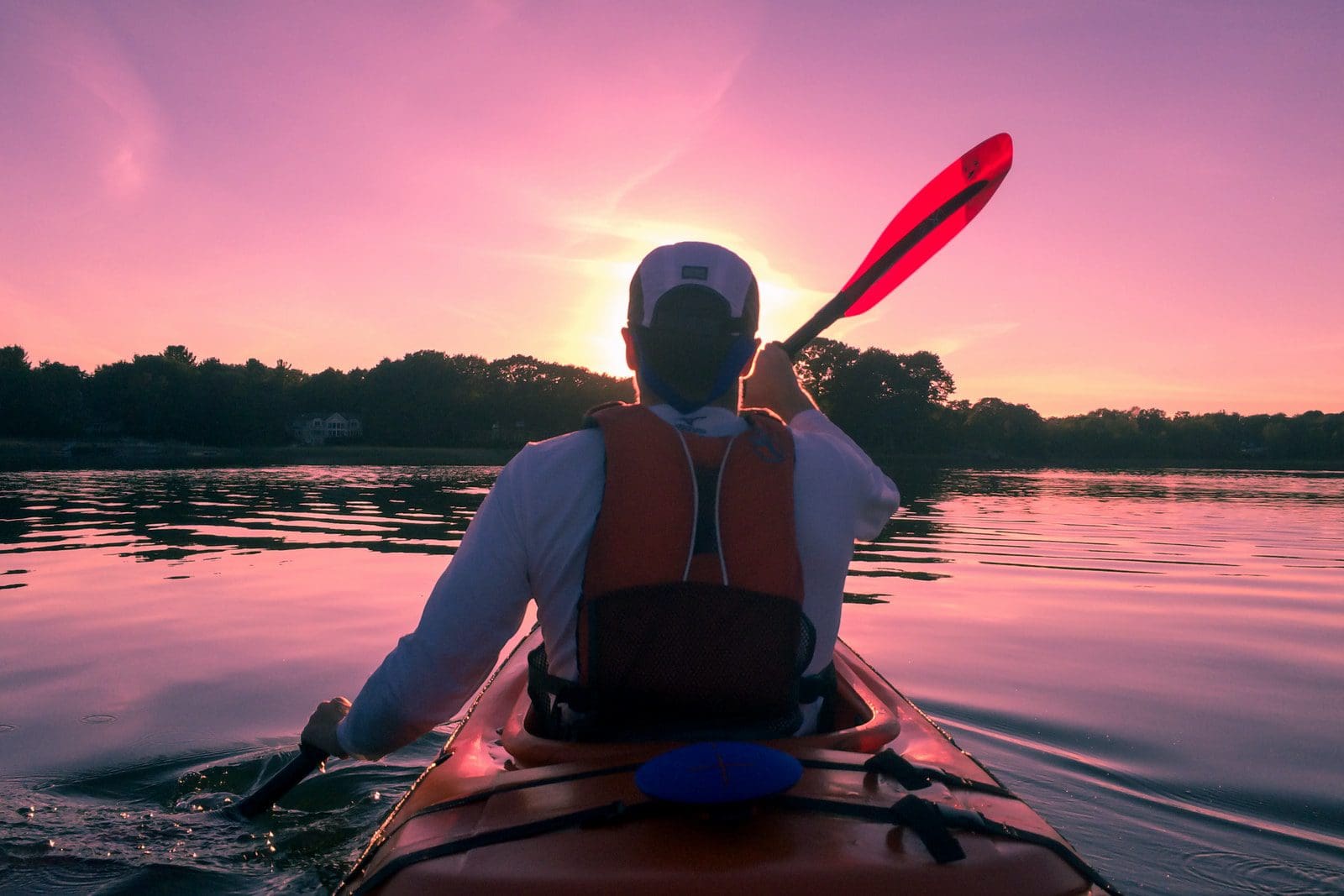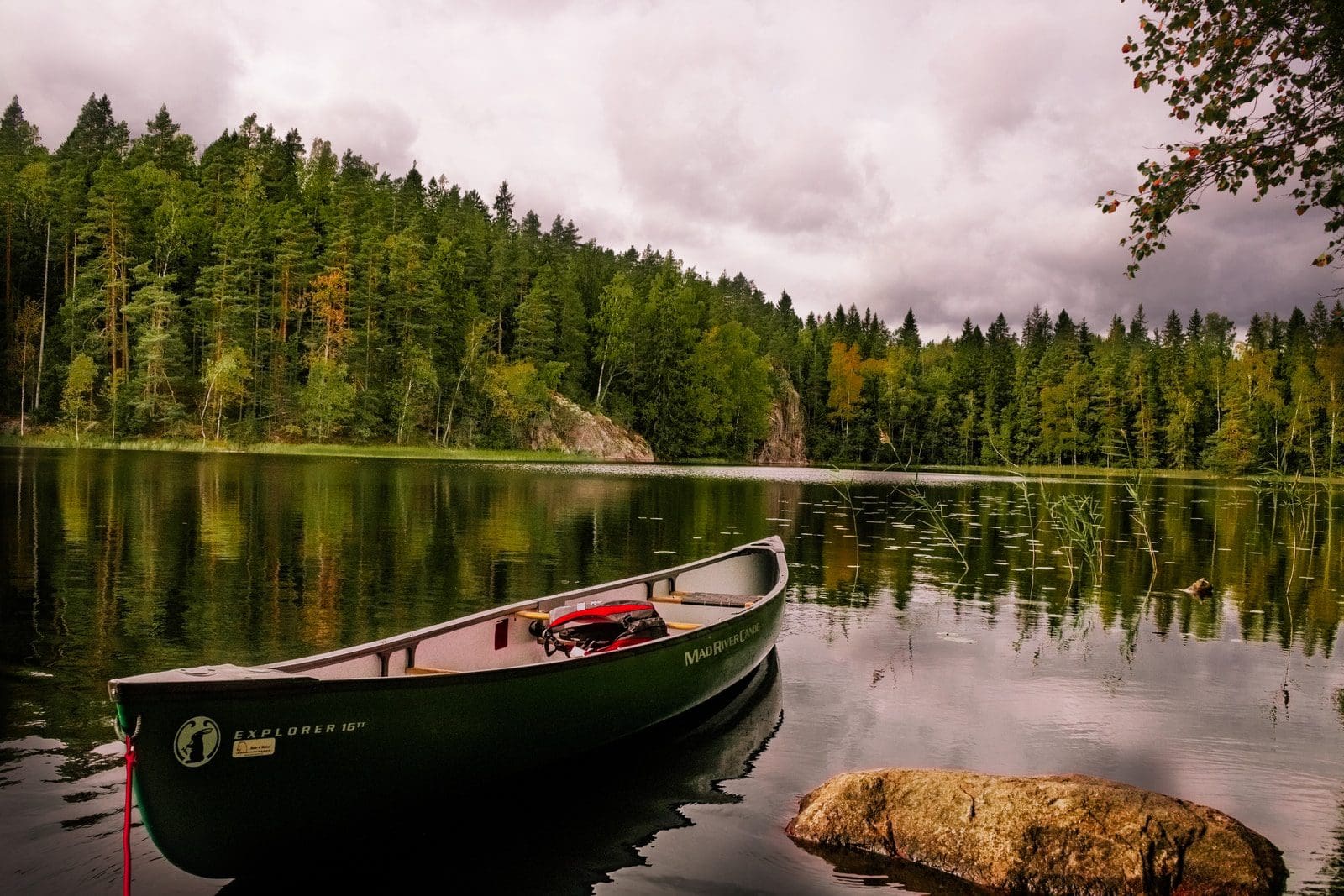Kayaks are sleek, narrow vessels designed for speed and agility, ideal for solo or tandem paddling in various water conditions. Canoes, with their open hull and higher sides, offer greater stability and storage capacity, perfect for leisurely exploration or carrying gear on multi-day trips. The choice between them boils down to preferred paddling style, water environment, and specific use requirements.
Key Takeaways
- Kayaks are designed for one or two paddlers, with a closed deck and a cockpit; canoes are open-decked and accommodate multiple passengers.
- Paddles in kayaking have blades on both ends; canoe paddles have a single blade.
- Kayaks are more maneuverable and faster, while canoes offer more stability and cargo space.
Kayak vs Canoe
The difference between the Kayak and canoe is that Kayak uses double-bladed paddles, and the passenger shall be in a sitting position. In contrast, the canoe employs a single curved-bladed paddle, and the passenger will kneel.

Comparison Table
| Feature | Kayak | Canoe |
|---|---|---|
| Seating Position | Sit-in (paddler enclosed in cockpit) or sit-on-top | Open (paddler kneels or sits on a raised seat) |
| Number of Paddlers | Typically 1 or 2 | Typically 2 or 3, but can accommodate more |
| Stability | Less stable due to narrower hull | More stable due to wider hull |
| Maneuverability | More maneuverable due to double-bladed paddle and smaller size | Less maneuverable due to single-bladed paddle and larger size |
| Speed | Generally faster and more efficient | Generally slower and less efficient |
| Ease of Paddling | Easier to learn and paddle for beginners due to seated position and double-bladed paddle | Requires more coordination and practice to paddle effectively |
| Entry and Exit | Can be challenging to enter and exit, especially for sit-in kayaks | Easier to enter and exit |
| Storage Capacity | Less storage space due to enclosed design | More storage space due to open design |
| Applications | Whitewater, open water, touring, fishing | Recreational paddling, fishing, camping trips, family outings |
| Price | Generally more expensive due to complex design | Generally less expensive due to simpler design |
What is Kayak?
Design and Construction:
- Hull Shape: Kayaks feature a sleek, narrow hull with a pointed bow and stern, optimized for speed, maneuverability, and efficiency in the water.
- Materials: Modern kayaks are constructed from a variety of materials including plastic, fiberglass, carbon fiber, and wood, each offering different combinations of durability, weight, and performance characteristics.
- Cockpit: The cockpit of a kayak is the area where the paddler sits. It’s enclosed by a rim called a coaming, which can accommodate a spray skirt to keep water out in rough conditions.
Types of Kayaks:
- Recreational Kayaks: These kayaks are designed for casual paddling on calm waters such as lakes and slow-moving rivers. They have a wider hull for stability and a larger cockpit for ease of entry and exit.
- Touring/Sea Kayaks: Touring kayaks are longer and narrower than recreational kayaks, optimized for covering longer distances with greater efficiency. They feature storage compartments for gear, making them suitable for multi-day expeditions.
- Whitewater Kayaks: Built for navigating fast-moving rivers and rapids, whitewater kayaks are shorter and more maneuverable, with a specialized hull design to ride waves and negotiate obstacles.
- Surf Kayaks: These kayaks are specifically designed for riding ocean waves, with features similar to those of surfboards such as fins and rocker for increased maneuverability and control.
Paddling Technique:
- Double-Bladed Paddle: Unlike canoes, which are propelled with a single-bladed paddle, kayaks utilize a double-bladed paddle for efficient forward propulsion. This technique requires coordination between both arms and a rotational movement of the torso for maximum efficiency.
- Bracing and Maneuvering: Paddlers use a combination of paddle strokes, including forward strokes, backward strokes, sweep strokes, and braces, to maneuver the kayak and maintain stability in different water conditions.

What is Canoe?
Design and Construction:
- Hull Shape: Canoes feature a broad, open hull with a pointed bow and stern, providing stability and ample space for passengers, gear, and cargo. The hull may have a slight rocker (upward curvature) for improved maneuverability.
- Materials: Traditional canoes were crafted from natural materials such as bark, wood, and animal skins. Modern canoes are constructed from a variety of materials including aluminum, fiberglass, plastic, and composite materials like Kevlar and carbon fiber, offering a balance of durability, weight, and performance.
- Seating: Canoes feature benches or seats for passengers, positioned closer to the gunwales (sides) to provide stability and ease of paddling. Some canoes also offer adjustable seats or seat backs for increased comfort during long journeys.
Types of Canoes:
- Recreational Canoes: These canoes are designed for leisurely paddling on calm waters such as lakes, ponds, and slow-moving rivers. They have a wider hull for stability and a flat bottom for easy maneuvering.
- Touring/Expedition Canoes: Touring canoes are longer and narrower than recreational canoes, optimized for covering longer distances with greater efficiency. They feature increased storage capacity for gear and supplies, making them suitable for multi-day trips and expeditions.
- Whitewater Canoes: Whitewater canoes are specifically designed for navigating fast-moving rivers and rapids. They are shorter and more maneuverable than touring canoes, with a specialized hull shape to ride waves and negotiate obstacles.
Paddling Technique:
- Single-Bladed Paddle: Canoes are propelled with a single-bladed paddle, which is alternately dipped into the water on either side of the canoe. Paddlers use a combination of forward strokes, sweep strokes, and draws to maneuver the canoe and maintain stability.
- Tandem vs. Solo Paddling: Canoes can be paddled solo or with multiple passengers. Tandem paddling involves two paddlers sitting side by side, each using a single-bladed paddle on opposite sides of the canoe. Solo paddling requires the paddler to sit in the center of the canoe and use a longer, single-bladed paddle.

Main Differences Between Kayak and Canoe
- Design:
- Kayaks have a sleek, narrow hull with a closed cockpit, while canoes feature a broad, open hull with no enclosed seating area.
- Paddles:
- Kayaks are propelled with a double-bladed paddle, whereas canoes are propelled with a single-bladed paddle.
- Purpose:
- Kayaks are designed for speed, agility, and solo or tandem paddling in various water conditions.
- Canoes are versatile crafts suitable for leisurely exploration, carrying gear, and accommodating multiple passengers or cargo.
- Stability:
- Canoes offer greater initial stability due to their wider hull design, making them easier for beginners to paddle.
- Kayaks provide greater secondary stability, allowing for more advanced maneuvers in rougher waters.
- Seating:
- Kayaks have a more defined seating area with adjustable seats, while canoes may feature benches or thwarts for passengers to sit on.
- Paddling Technique:
- Kayakers use a combination of strokes with a double-bladed paddle, focusing on torso rotation for efficient propulsion.
- Canoeists utilize single-bladed paddles and various paddling techniques, including forward strokes, sweeps, and draws, in tandem with another paddler for stability and speed.

While the article is informative, it could benefit from addressing the environmental impact of water sports. It’s important to consider sustainability in these discussions.
That’s a valid point, Amy. Environmental considerations are crucial when discussing water-based activities.
I agree with Amy. It would be great to see a section on environmental responsibility in future articles.
The article provides an insightful exploration of kayaks and canoes. However, I’d love to see an analysis of the economic impact of water sports in future pieces.
That’s an interesting perspective, Uwalker. Analyzing the economic aspects of water sports could offer valuable insights.
The article provides a comprehensive and informative comparison between kayaks and canoes, and even delves into the history of both watercrafts. I found it very interesting and entertaining to read.
I absolutely agree. It’s a great read for anyone interested in water sports and leisure activities.
I didn’t know that kayaking has so many health benefits. This article has certainly made me consider taking up kayaking.
The article effectively outlines the differences between kayaks and canoes, but it would be interesting to see a more humorous take on the subject in future pieces.
Interesting suggestion, Adam. Adding a touch of humor could make the topic even more engaging for readers.
I agree with Adam. Injecting some humor into the article could make it more appealing to a wider audience.
The health benefits associated with kayaking presented in the article are certainly intriguing. It’s great to see the physical and mental advantages of leisure activities highlighted.
I agree, Christopher. It’s important to recognize the holistic benefits of engaging in water sports.
The detailed comparison between kayaks and canoes has expanded my knowledge about these watercrafts. It’s a great read for anyone interested in exploring water-based activities.
I share your sentiments, Joel. The article offers valuable insights into the world of kayaks and canoes.
I’m glad the article resonated with you, Joel. It’s a thoughtful exploration of water sports.
The health benefits of kayaking highlighted in the article are certainly intriguing. I never realized that kayaking could offer such a range of advantages.
Agreed, Reece. I’m pleasantly surprised by the diverse benefits associated with kayaking.
The author has done a fantastic job of presenting the differences between kayaks and canoes in a clear and concise manner. It’s a great resource for beginners looking to get into water sports.
I agree, the detailed comparison table is especially helpful for those who are new to these watercrafts.
I appreciate the historical context included in the article. It adds depth to the discussion of kayaks and canoes.
The historical background provided about kayaks and canoes is fascinating. I enjoyed learning about the origins and cultural significance of these watercrafts.
Agreed, Rob. The historical insights provide a well-rounded understanding of kayaks and canoes.
The historical context definitely adds depth to the discussion. It’s an enriching aspect of the article.
The article offers a comprehensive overview of kayaks and canoes, but it could be improved by including more diverse perspectives on their cultural significance.
A valid critique, John. Exploring the cultural and historical significance of these watercrafts from a global perspective would enhance the article.